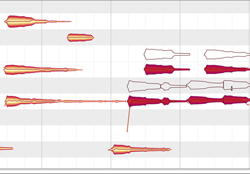Here are some simple steps that can help insure that your vocal track is working together with the rest of your mix.
Cleanup
Before anything, clean up the vocal tracks. Go through and trim the silence around each phrase. Remove any noise, thumps, clicks, pops and gasps. Fade in or out on each edit.
Pitch Correction
Gentle pitch correction with software like Melodyne is a big part in getting that professional sounding vocal we all strive for in our studio productions. Be careful with this! Doing it right takes time and practice. Over-tuned vocals are about as bad as out of tune vocals. Let’s be honest here, we’ve heard both on American Idol.
EQ
There are no rules here, and every voice is different, but here are some starting points. A high-pass filter (low cut) can be used to quickly and easily clean up the very lows (below 100 Hz). Right above there from 200-600 Hz can be gently boosted or cut depending on the voice to add thickness or compensate for proximity.
Another area worthy of focus is from 1 kHz-3 kHz which usually where the clarity of the vocals can be brought out. Above that is brightness, bite, and air but look out for sibilance! How much you can boost here depends entirely upon the song and the singer.
Compression
When it comes to controlling vocal dynamics, using two compressors doing less individually often yields the most transparent result. Use a compressor with fast attack and high ratio (10:1) working just on the peaks, ignoring everything else. The second compressor is best set with a 4:1 ratio, a slower attack and release and threshold set so it’s compressing about 2-4dB.
Reverb
This is an effect you’ll want to place to an auxiliary track rather than having it right on the vocal track. Use a send to add the reverb to the vocals. The reverb time should be related to the tempo of the song, it can really clutter the mix if it’s not. “Hall” and “Plate” are the most common types of reverb for vocals. Shaping the reverb sound with EQ is recommended.
Automation
Automating the volume level of the vocals is absolutely essential to getting the vocal to sit right where you want it throughout the song. Automating the reverb send for the vocal will allow you to have just the right amount at any time. You can also automate effects like chorus and delays for the vocals to keep things interesting through the song.
Vocal Sweetening
A great all-in-one tool for vocal processing is something like iZotope Nectar. Eleven effects in one plugin including EQ, Compression, Auto and Manual Pitch Correction, reverb, delay and more.
Be sure to try out some of these tricks the next time you mix vocals.
Jon Tidey is a producer/engineer who runs his own studio, EPIC Sounds, and enjoys writing about audio on his blog AudioGeekZine.com.





















